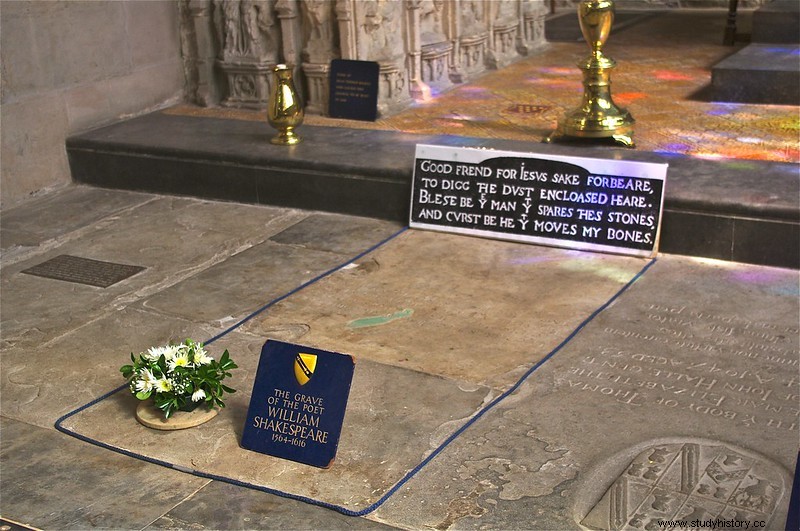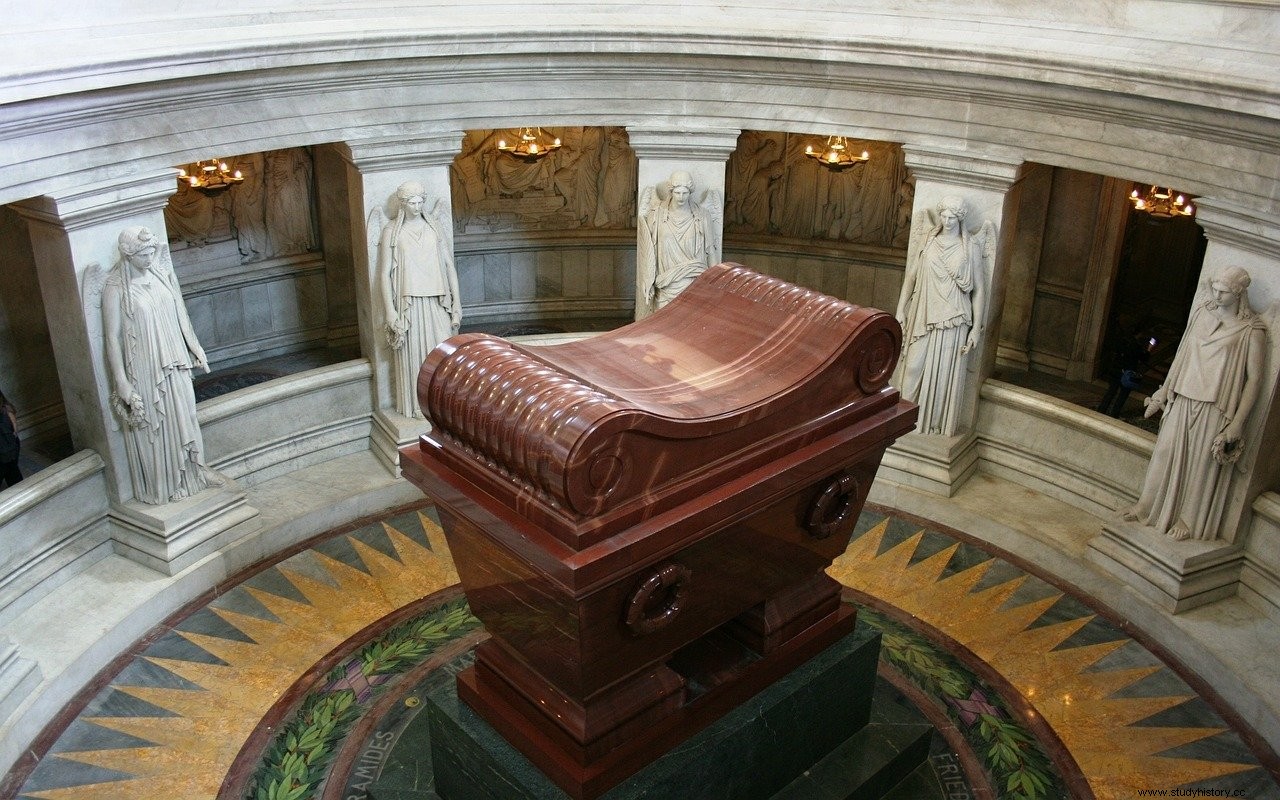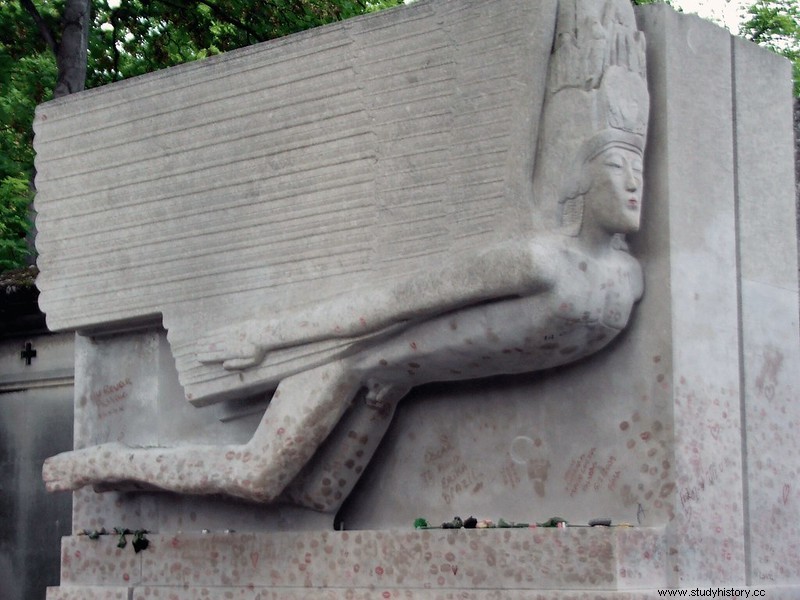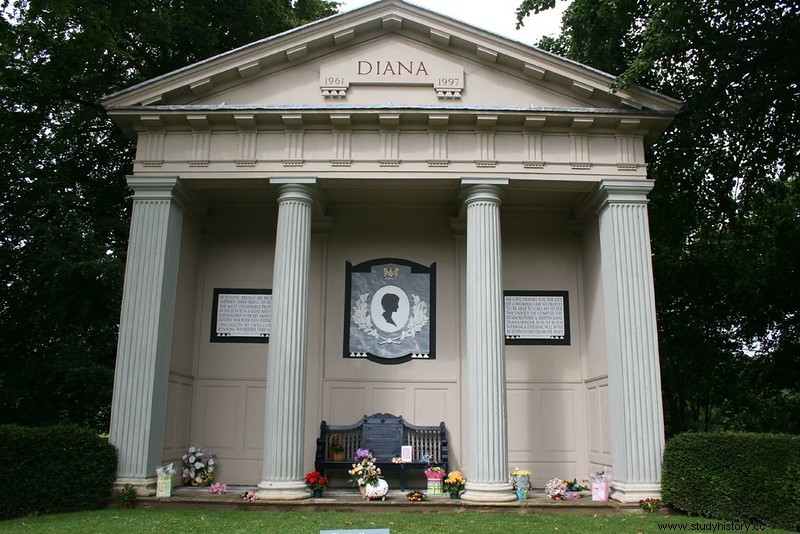Very few people receive the posthumous honor of being greater than life. Truly legendary story figures have immortalized their lives in the public consciousness. But have you ever wondered what happened afterwards? When life was over, where were they buried? Or have you ever wondered if there was more to the story after their death?
If it's you, do not worry. I was in the exact same boat not so long ago. So I have struggled to gather information about death and final resting places for some of history's most famous figures to present to you here. So sit back, relax, and maybe learn something new about some of history's most famous people.
William Shakespeare, 1564 - 1616

History
Not much is known about William Shakespeare, the man behind many of the most famous plays of all time. Most of what we know is about his long product catalog, which ranges from tragedy to comedy with notable works such as Romeo and Juliet , Much Ado About Nothing and Hamlet .
But the circumstances surrounding his death are still shrouded in mystery and uncertainty. One month before his death, Shakespeare had written in his will that he was "in good health." Many scholars have since speculated on the subject of his death, but there are not enough details to come to any firm conclusions.
Burial
Shakespeare's family buried him in Stratford-upon-Avon at the Church of the Holy Trinity, where his wife Anne would eventually join him. There is a message carved on a stone over his grave that speaks of a curse placed on everyone who moves his legs. In modern English, the epitaph reads:
Good friend, for Jesus' sake
Digging the dust attached here.
Blessed be the man who spares these stones,
And it's the one that moves my legs.
"William Shakespeare." Encyclopædia Britannica , Encyclopædia Britannica, Inc., www.britica.com/biography/William-Shakespeare/Career-in-the-theatre#ref232304.
Those who had the task of restoring the chapel in 2008 took it seriously and made sure not to move the tomb during the restoration process.
The church also has a burial monument dedicated to Bard which dates back to the 1620s. It has a statue of Shakespeare in the middle of the writing and a plaque written in early modern English.
The Church of the Holy Trinity is still in operation, and it serves a parish of 17 people. Visitors who make a small contribution to the church can enter the room that contains Shakespeare's tomb and burial monument.
Napoleon Bonaparte 1769 - 1821

History
Napoleon Bonaparte was one of the most beloved and feared men in Europe in his time. He was Emperor of France from 1804 - 1815 and known for his aggressive ambitions. Napoleon was an excellent military strategist and led many successful campaigns. However, he was eventually defeated and banished to the island of Elba. He returned briefly to France in 1815, but was defeated in Waterloo by the British and Prussians not long afterwards. Napoleon was once again exiled, this time to the remote island of St. Helena. He remained there until his death.
The cause of his death is still under speculation, but a popular theory is that it was due to some form of stomach disease. He first began to show signs of illness in 1817, but the condition worsened drastically in 1821. Napoleon was imprisoned in the spring and wrote his will not long after. He died May 5 th , 1821.
Burial
Napoleon explained how he wanted to be buried on the banks of the river Seine in France. Instead, the British governor in charge of exile chose to bury him in St. Helena.
In the 1830s, however. Emotions for Pro-Napoleon increased. The newly established monarchy, led by Louise Phillipe I, was eager to take advantage of it and serve its citizens. In 1840, Louis Phillipe received permission from the British government to send his son Francois to St. Helena and return Napoleon's remains to France. The former emperor received a state funeral when he returned. An elaborate tomb at Les Invalides was constructed to be his final resting place.
Today, Les Invalides is a collection of museums and memorials centered on France's military history. Tickets can be purchased for 12 euros and are valid for admission to all Les Invalides museums. For 2.5 euros extra you can go on a guided tour of Napoleon's tomb and learn a little more about the famous emperor.
Karl Marx, 1818 - 1883

History
Perhaps one of the most famous philosophers of all time, Karl Marx is known (or perhaps notorious) for his influence on political movements such as communism and socialism. His most famous work is the 1848s The Communist Manifesto. His faith meant that he was unwelcome in many lands, and he had no choice but to move frequently around Europe.
Marx was ill most of his life. He suffered from liver diseases and eye inflammation, among other things. In 1881 he developed a catarrh (inflammation of the mucus in one of the body's airways). This catarrh developed into bronchitis, which inevitably killed him March 14 th , 1883.
Burial
His death was announced two days later and in Paris. Newspapers issued a correction the next day, but by the way, he had already been buried in a section of Highgate Cemetery reserved for agnostics and atheists. A small selection of his friends and family attended his funeral, including his surviving daughters, his two sons-in-law, and his closest associate, Friedrich Engels.
In 1954, Marx was reburied to a new location and given the tomb that still adorns his tomb today. The Communist Party of Great Britain ordered the large bust of Marx sitting on top of his grave.
Oscar Wilde, 1854 - 1900

History
Although he is now known for writing the classic novel The Picture of Dorian Gray, Oscar Wilde was best known for his plays in his time. His most critically acclaimed play of the period was The Importance of Being Honest.
Things went downhill for Wilde when he was tried and found guilty of sodomy (having sex with another man). His sentence was two years' hard work in prison. Working and living conditions took a toll on Wilde's health. He broke his right eardrum in a fall during this time, one of the potential causes of his death a few years later.
After imprisonment, Wilde left Britain for France, never to return. He lived in Paris under a new name, and had little income and few friends. He wrote a recent work, The Ballad of Reading Gaol. Most of Wilde's time was spent drinking and trying to stay out of the public eye. He developed meningitis in the autumn of 1900, and he died not long after.
Burial
He was originally buried outside Paris, but in 1909 his remains were transferred to a cemetery inside the city. One of Wilde's lovers, Robert Ross, ordered a tomb depicting an angel for him. He also included a small room for his own ashes, eventually placed there in 1950. The angel's original genitals were stolen once afterwards. An artist would eventually install a replacement made of silver.
Visitors and fans would often leave lipstick marks on Wilde's grave as a way to show admiration. At one point, they covered the lower half of the tomb. However, in 2011 the French government issued a cleaning of Wilde's grave. They also installed a glass barrier around the tomb to prevent the practice from continuing.
Jimi Hendrix, 1942 - 1970

History
Despite having a relatively short career, Hendrix is considered one of the greatest and most influential guitarists of all time. He was the background guitarist for various artists at the beginning of his career before he was discovered in a club in New York City. He moved to England and met a drummer and bassist who would become his bandmates:Mitch Mitchell and Noel Redding.
Together they formed the Jimi Hendrix Experience which quickly took off, primarily thanks to Hendrix himself. His innovative guitar playing left a mark on the audience, combining several genres of music and incorporating feedback into his sound in a way that no one else was. Jimi Hendrix Experience would continue to release three studio albums before hitting in mid-1969. Hendrix would play shows and record music alone and by teaming up with others. Jimi Hendrix Experience would reunite and begin work on another album, but Hendrix would not see the project complete. Hendrix died of an overdose of barbiturates in London on September 18 th , 1970.
Burial
Hendrix was flown back to the United States and buried in the same cemetery as his mother, Greenwood Cemetery in Renton. However, his father decided that his son deserved something better than the simple tombstone they had originally used. Completed in 2002, the new dome-like memorial included a portrait of the deceased guitarist on one of the columns and is surrounded by the plots of his immediate family members.
Jimi Hendrix is one of the most notable members of the "27 Club." The 27 club is not a real club, but instead a pop culture myth that claims that celebrities are more likely to die at the age of 27. The concept originated around the time Hendrix died, when many famous musicians died at the age of 27 in the years around, like Janis Joplin, Jim Morrison and Brian Jones. Research has shown that there is no evidence for the claim of 27 Club, but the idea has persisted.
Diana, Princess of Wales, 1961 - 1997

History
Diana, known as the Princess of the People, married Prince Charles, heir to the British throne, in 1981 after a brief courtship. She was the first British woman in three hundred years to marry the heir to the throne. Diana would be incredibly popular with the public thanks to her down-to-earth nature, iconic fashion sense and her great commitment to many charitable causes.
As time went on, the marriage issues between Diana and Charles became clearer. Charles began an affair with his ex-girlfriend, Camilla Bowles, five years after the marriage. Diana later had an affair with a riding instructor. Charles admitted to being unfaithful to Diana in June 1994 on television. The dress she wore to a public event the night the recording was broadcast became known as "The Revenge Dress". The couple was to officially divorce in 1996.
It would only be a year later that Diana would die unexpectedly. She had been in Paris with her current partner, Dodi Fayed. They left the Ritz Hotel with a driver and Fayed's bodyguard while trying to lose the paparazzi who accompanied them. The car went out of control and crashed. The accident killed Fayed and the driver immediately. Diana died at a hospital later that night.
Burial
Millions turned out to be standing along the streets watching Princess Diana's funeral procession. Prince Charles, his brother and her two sons all walked behind her coffin as it made its way to Westminster Abbey.
Diana's good friend Elton John also attended the funeral. He performed a new version of the song Candle in the Wind as a tribute to her. Named Candle in the Wind 1997 , it will continue to be 2 nd the best-selling physical single of all time. All proceeds went to charities Diana was involved in.
An island in Althorp Park, part of Diana's family estate, was chosen as her final resting place.
To this day, Diana is remembered and mourned. Her legacy is still seen today, whether it is for her iconic fashion sense or for charitable activities.
Death does not end history
During my research of this article, I did not expect how often a person's story did not end after they died. Whether through a legacy, a myth or a lasting influence on pop culture and politics, for some famous and iconic people, death is not their last chapter.
So I advise you to do some research on your own. Look up some of your famous favorite characters and investigate their deaths and afterwards. You may just be surprised at what you want to learn.
